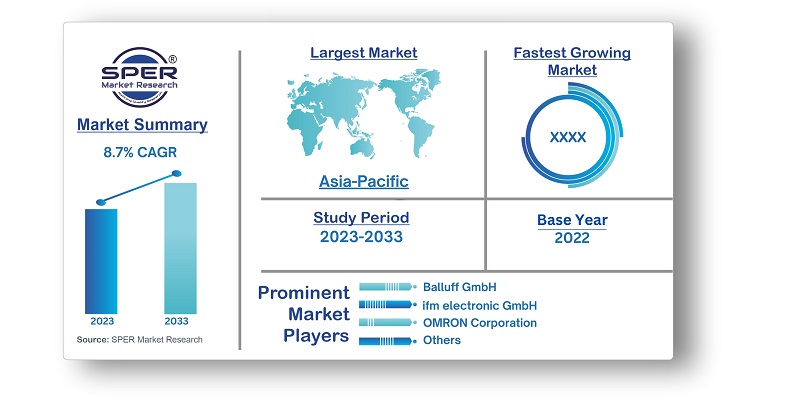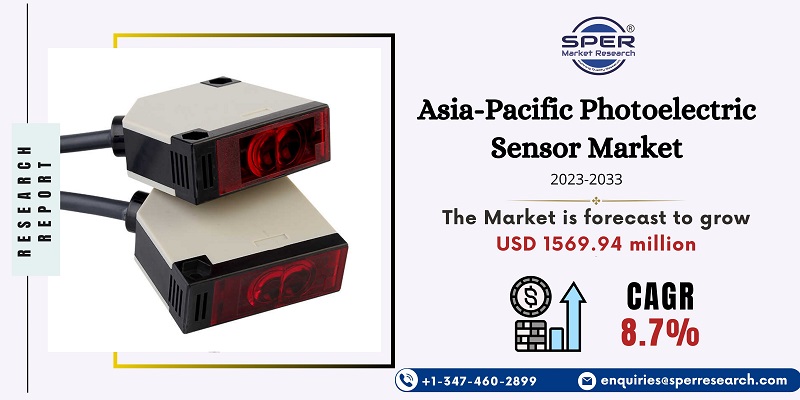
Asia Pacific Photoelectric Sensor Market Growth, Size, Trends, Revenue, Share and Future Outlook
Asia Pacific Photoelectric Sensor Market Size- By Type, By Application, By Range, By Structure, By Beam Source, By Output- Regional Outlook, Competitive Strategies, and Segment Forecast to 2033
| Published: Jan-2024 | Report ID: SEMI2404 | Pages: 1 - 156 | Formats*: |
| Category : Semiconductor and Electronics | |||
- October 2019: Together, Verizon and NEC Corporation conducted a trial test of integrating NEC Corporation's innovative photo sensor technology into Verizon's already-ground photo fiber line. Software that supports artificial intelligence (AI) is linked with the technology to enable intelligent traffic monitoring, which includes measurements of vehicle direction, density, acceleration, speed, deceleration, and other factors.
- February 2018: Optical heart rate monitoring sensors for smartwatches and brands were introduced by ROHM CO. With a sampling rate of around 1024 Hz, the sensor may monitor stress, blood pressure, and vascular age.


| Report Metric | Details |
| Market size available for years | 2019-2033 |
| Base year considered | 2022 |
| Forecast period | 2023-2033 |
| Segments covered | By Type, By Application, By Range, By Structure, By Beam Source, By Output |
| Regions covered | China, India, Japan, Australia, Indonesia, Philippines, Thailand, and Malaysia. |
| Companies Covered | Balluff GmbH; ifm electronic GmbH; OMRON Corporation; Rockwell Automation, Inc.; Eaton Corporation plc., Panasonic Corporation; SICK AG; Autonics Corporation, Schneider Electric SE; and Keyence Corporation |
- Manufacturers and suppliers
- System Integrators
- End-User Industries
- Research and Development Professionals
- Regulatory authorities
- Investors and Financial institutions
- Consulting and advisory firms
- Educational and training institutions
- System Designers and engineers
- Maintenance and service providers
| By Type: |
|
| By Application: |
|
| By Range: |
|
| By Structure: |
|
| By Beam Source: |
|
| By Output: |
|
- Asia-Pacific Photoelectric Sensor Market Size (FY’2023-FY’2033)
- Overview of the Asia-Pacific Photoelectric Sensor Market
- Segmentation of Asia-Pacific Photoelectric Sensor Market By Type (Reflective Photoelectric sensors, Retroreflective Photoelectric sensors, Through-Beam Photoelectric sensors)
- Segmentation of Asia-Pacific Photoelectric Sensor Market By Application (Automotive Transportation, Building Automation, Consumer Electronics, Food and beverages, Industrial Manufacturing, Packaging, Pharmaceuticals and medical)
- Segmentation of Asia-Pacific Photoelectric Sensor Market By Structure (Built-in-amplifier, Built-in-power Supply, Fiber Type, Separate Amplifier)
- Segmentation of Asia-Pacific Photoelectric Sensor Market By Range ( 100-1000 Mm, 1000-10,000 Mm, > 10,000 Mm)
- Segmentation of Asia-Pacific Photoelectric Sensor Market By Beam Source (Laser Beam Source, Standard Beam Source)
- Segmentation of Asia-Pacific Photoelectric Sensor Market By Output (Digital And Analog)
- Statistical Snap of Asia-Pacific Photoelectric Sensor Market
- Expansion Analysis of Asia-Pacific Photoelectric Sensor Market
- Problems and Obstacles in Asia-Pacific Photoelectric Sensor Market
- Competitive Landscape in the Asia-Pacific Photoelectric Sensor Market
- Impact of COVID-19 and Demonetization on Asia-Pacific Photoelectric Sensor Market
- Details on Current Investment in Asia-Pacific Photoelectric Sensor Market
- Competitive Analysis of Asia-Pacific Photoelectric Sensor Market
- Prominent Players in the Asia-Pacific Photoelectric Sensor Market
- SWOT Analysis of Asia-Pacific Photoelectric Sensor Market
- Asia-Pacific Photoelectric Sensor Market Future Outlook and Projections (FY’2023-FY’2033)
- Recommendations from Analyst
1.1. Scope of the report1.2. Market segment analysis
2.1. Research data source2.1.1. Secondary Data2.1.2. Primary Data2.1.3. SPER’s internal database2.1.4. Premium insight from KOL’s2.2. Market size estimation2.2.1. Top-down and Bottom-up approach
2.3. Data triangulation
4.1. Driver, Restraint, Opportunity, and Challenges Analysis4.1.1. Drivers4.1.2. Restraints4.1.3. Opportunities4.1.4. Challenges4.2. COVID-19 Impacts on the Asia-Pacific Photoelectric Sensor Market
5.1. SWOT Analysis5.1.1. Strengths5.1.2. Weaknesses5.1.3. Opportunities5.1.4. Threats5.2. PESTEL Analysis5.2.1. Political Landscape5.2.2. Economic Landscape5.2.3. Social Landscape5.2.4. Technological Landscape5.2.5. Environmental Landscape5.2.6. Legal Landscape5.3. PORTER’s Five Forces5.3.1. Bargaining power of suppliers5.3.2. Bargaining power of buyers5.3.3. Threat of Substitute5.3.4. Threat of new entrant5.3.5. Competitive rivalry5.4. Heat Map Analysis
6.1. Asia-Pacific Photoelectric Sensor service Market Manufacturing Base Distribution, Sales Area, Product Type6.2. Mergers & Acquisitions, Partnerships, Product Launch, and Collaboration in Asia-Pacific Photoelectric Sensor service Market
7.1. Asia-Pacific Photoelectric Sensor Market Value Share and Forecast, By Type, 2023-20337.2. Reflective Photoelectric sensors7.3. Retroreflective Photoelectric sensors
7.4. Through-Beam Photoelectric sensors
8.1. Asia-Pacific Photoelectric Sensor Market Value Share and Forecast, By Application, 2023-20338.2. Automotive Transportation8.3. Building automation8.4. Consumer Electronics8.5. Food and beverages8.6. Industrial Manufacturing8.7. Packaging
9.1. Asia-Pacific Photoelectric Sensor Market Value Share and Forecast, By Range, 2023-20339.2. 100-1000 Mm9.3. 1000-10,000 Mm9.4. > 10,000 Mm
9.5. Asia-Pacific Photoelectric Sensor Market Value Share and Forecast, By Structure, 2023-20339.6. Built-in-amplifier9.7. Built-in-power Supply9.8. Fiber Type9.9. Separate Amplifier
10.1. Asia-Pacific Photoelectric Sensor Market Value Share and Forecast, By Beam source, 2023-203310.2. Laser Beam Source10.3. Standard Beam Source
11.1. Asia-Pacific Photoelectric Sensor Market Value Share and Forecast, By output, 2023-203311.2. Digital11.3. Analog
12.1. Asia-Pacific Photoelectric Sensor Market Size and Market Share
13.1. Asia-Pacific Photoelectric Sensor Market Size and Market Share By Type (2019-2026)13.2. Asia-Pacific Photoelectric Sensor Market Size and Market Share By Type (2028-2034)
14.1. Asia-Pacific Photoelectric Sensor Market Size and Market Share By Application (2019-2026)14.2. Asia-Pacific Photoelectric Sensor Market Size and Market Share By Application (2027-2033)
15.1. Asia-Pacific Photoelectric Sensor Market Size and Market Share By Range (2019-2026)15.2. Asia-Pacific Photoelectric Sensor Market Size and Market Share By Range (2027-2033)
16.1. Asia-Pacific Photoelectric Sensor Market Size and Market Share By Structure (2019-2026)16.2. Asia-Pacific Photoelectric Sensor Market Size and Market Share By Structure (2027-2033)
17.1. Asia-Pacific Photoelectric Sensor Market Size and Market Share By Beam Source (2019-2026)17.2. Asia-Pacific Photoelectric Sensor Market Size and Market Share By Beam Source (2027-2033)
18.1. Asia-Pacific Photoelectric Sensor Market Size and Market Share By Output (2019-2026)18.2. Asia-Pacific Photoelectric Sensor Market Size and Market Share By Output (2027-2033)
19.1. Asia-Pacific Photoelectric Sensor Market Size and Market Share By Region (2019-2026)19.2. Asia-Pacific Photoelectric Sensor Market Size and Market Share By Region (2027-2033)19.3. Aisa-Pacific19.4. China19.5. India19.6. Japan19.7. Australia19.8. Indonesia19.9. Philippines19.10. Thailand19.11. Malaysia
20.1. Autonics Corporation20.1.1. Company details20.1.2. Financial outlook20.1.3. Product summary20.1.4. Recent developments20.2. Balluff GmbH20.2.1. Company details20.2.2. Financial outlook20.2.3. Product summary20.2.4. Recent developments20.3. Eaton Corporation PLC.20.3.1. Company details20.3.2. Financial outlook20.3.3. Product summary20.3.4. Recent developments20.4. ifm electronic GmbH20.4.1. Company details20.4.2. Financial outlook20.4.3. Product summary20.4.4. Recent developments20.5. Keyence Corporation20.5.1. Company details20.5.2. Financial outlook20.5.3. Product summary20.5.4. Recent developments20.6. OMRON Corporation20.6.1. Company details20.6.2. Financial outlook20.6.3. Product summary20.6.4. Recent developments20.7. Panasonic Corporation20.7.1. Company details20.7.2. Financial outlook20.7.3. Product summary20.7.4. Recent developments20.8. Rockwell Automation, Inc.20.8.1. Financial outlook20.8.2. Product summary20.8.3. Recent developments20.9. Schneider Electric SE20.9.1. Company details20.9.2. Financial outlook20.9.3. Product summary20.9.4. Recent developments20.10. Others
SPER Market Research’s methodology uses great emphasis on primary research to ensure that the market intelligence insights are up to date, reliable and accurate. Primary interviews are done with players involved in each phase of a supply chain to analyze the market forecasting. The secondary research method is used to help you fully understand how the future markets and the spending patterns look likes.
The report is based on in-depth qualitative and quantitative analysis of the Product Market. The quantitative analysis involves the application of various projection and sampling techniques. The qualitative analysis involves primary interviews, surveys, and vendor briefings. The data gathered as a result of these processes are validated through experts opinion. Our research methodology entails an ideal mixture of primary and secondary initiatives.



Frequently Asked Questions About This Report
PLACE AN ORDER
Year End Discount
Sample Report
Pre-Purchase Inquiry
NEED CUSTOMIZATION?
Request CustomizationCALL OR EMAIL US
100% Secure Payment






Related Reports
Our Global Clients
Our data-driven insights have influenced the strategy of 200+ reputed companies across the globe.




















